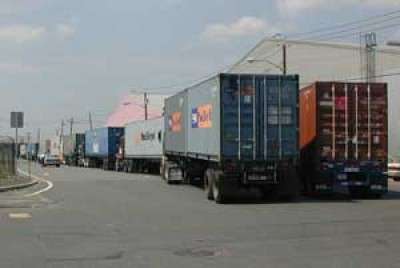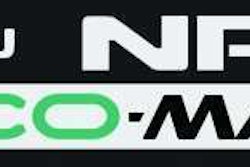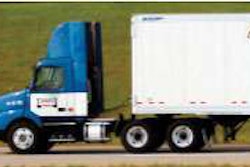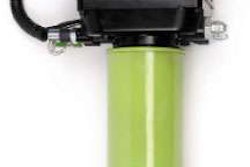
The Port Authority of New York and New Jersey and the U.S. Environmental Protection Agency today, March 10, announced the phasing-out of the oldest diesel trucks servicing port facilities by Jan. 1, 2011 – replacing them with cleaner vehicles to help improve the air quality in surrounding communities.
The Port Authority and EPA collaborated with the Natural Resources Defense Council, industry, labor and community groups to develop this new program that starting next year will replace 636 trucks made before 1994 that regularly service the port. This move is designed to cut soot pollution from these trucks by two-thirds and smog-forming pollution in half. By 2017, the program also will replace all of the more than 4,500 trucks that regularly service the port with engines made before 2007. Engines made after 2007 are certified to the EPA’s highest soot standards and are 95 percent cleaner than older trucks.
The program provides $28 million in joint financial assistance from EPA stimulus funds and the Port Authority to help drivers switch from their pre-1994 trucks to cleaner, more efficient vehicles. Specifically, trucks drivers will be eligible for a 25 percent grant toward the total purchase price of a replacement truck, as well as low-interest financing – 5.25 percent over five years – for up to 75 percent of the total purchase price. Drivers that regularly call on the port’s marine terminals are eligible for assistance. Information about the program and about the application process is available at the Truck Replacement Center at 1180 McLester St., Elizabeth, N.J., or online at www.replacemytruck.org, or in Spanish at www.cambiamicamion.org.
“Today we’ve launched a plan to eliminate some of the dirtiest diesels in our midst and make the port more sustainable,” said Richard Kassel, director of NRDC’s Clean Fuels and Vehicles Project and co-chair of the work group that designed the new program. “Nobody drives a 30-year-old truck because they like the exhaust – they drive them because they can’t afford to buy a newer truck. With this program, drivers will get the financing incentives they need to upgrade from their old, dirty diesel vehicles to newer, cleaner and more reliable trucks. This means fresher air for drivers and for neighboring communities – from Elizabeth, to Newark and New York. We look forward to building on today’s announcement to ensure that we’re moving goods throughout our region in the cleanest, most competitive and sustainable way possible.”
The program is partly funded by a $7 million EPA grant, with the remainder coming from Port Authority funds. “Efforts like the Port Authority’s new truck replacement program and the much broader sustainability agreement signed today will go a long way toward cutting this pollution and improving air quality and public health,” says EPA Region 2 Administrator Judith Enck said, “Trucks and equipment used at ports are a significant source of pollution in the communities that surround them. Reducing dirty diesel emissions will protect the health of truck drivers and the workers at the port, along with the nearby community. I applaud the Port Authority for its leadership.”
The initiative was the result of months of discussions undertaken by members of the Port Authority’s Truck Working Group, a broad coalition comprising members of state and private sector environmental organizations, trucking groups, labor and the maritime industry. “The Clean Truck Program is the latest in our efforts to achieve cleaner air at and around our port,” says Port Authority Chairman Anthony R. Coscia. “On top of our other investments – including $600 million to build on-dock rail and $60 million to acquire and preserve environmentally sensitive property – we believe this program will help build on our legacy as good environmental stewards.”
The Retail Industry Leaders Association – a partner with the Coalition for Responsible Transportation, which assisted the port in the CTP’s development – applauded the announcement. CRT is known for its financing model that helped truckers acquire new vehicles to meet the requirements of the CTPs in the Port of Los Angeles and Long Beach. RILA partnered with CRT in 2009 to expand efforts to reduce diesel emissions in and around our nation’s ports. “The Port of NY/NJ clean truck program seizes upon the demonstrated commitment of the shipping industry to work collaboratively with the port authorities and the communities to improve air quality without unnecessarily interrupting the flow of commerce,” said Katherine Lugar, RILA executive vice president for public affairs.
The American Trucking Associations also congratulated the port for developing a plan that focuses on reducing truck pollution through the retirement of older diesel engines and not on requirements to ban owner-operator truck drivers from hauling freight at the port. “I would like to express our appreciation to the leadership of the Port Authority of New York and New Jersey who managed the development of this Clean Truck initiative,” said Curtis Whalen, executive director of ATA’s Intermodal Motor Carriers Conference. “While the stakeholder participants often did not totally agree on the program specifics, all were given the opportunity to express their views, and in the end consensus was reached to move ahead with a plan to reduce emissions through a subsidized program aimed at modernizing the port’s truck drayage fleet.”
ATA said that while NY/NJ moves toward full program implementation, it urged port officials to continue evaluating freight volume movements and projections to ensure that sufficient operational revenues are available to cover the new truck purchase obligations that now will be generated by the CTP. “Given the continuing effects of the recession that still grips our country and this region, the Port Authorities should be sensitive to the current economic conditions, including the very uncertain levels of future freight volumes, in determining the appropriate timing for full implementation of the program,” Whalen said. “While fully supportive of the clean air goals, the drayage industry is in a particularly vulnerable position that may counsel for a ‘go-slow’ approach until the economic climate improves.”
But Amy Goldsmith, chair of the Coalition for Healthy Ports and executive director of the New Jersey Environmental Federation, said her while her groups welcome the initial step the Port Authority is taking to reduce truck emissions, it will take far greater strides to achieve and sustain clean air. “While we look forward to next year’s official retirement of dirty trucks built before 1994, it will account for less than 10 percent of the total port trucking fleet, leaving thousands of toxic spewing diesel trucks on the road,” Goldsmith said. “Clearly, the only thing aggressive about this environmental measure is that it places a severe economic burden on port truck drivers who average $10 to 11 an hour and lack a safety net, rather than the giant shipping companies and trucking outfits that profit from goods movement.”
Goldsmith said that under the current plan, owner-operators will be required to assume debt to purchase cleaner trucks in order to continue working at the port. “Experiences from other ports around the country provide real-world examples for the Port Authority of New York & New Jersey to consider,” said Goldsmith, reference a publicly funded grant program in Oakland established to help drivers upgrade and purchase new trucks that ran out of money, leaving officials scrambling for more state and federal funds as an estimated 1,000 truckers face unemployment.
In Long Beach, continuous news reports profile drivers whose already low incomes have been “trimmed to new lows” in order to meet payments on clean vehicles, Goldsmith said. “This not a model to replicate, nor is it a cause for clean-air celebration,” she said. “That is why we strongly advocate for a plan that requires the capitalized shipping and trucking industry to take responsibility for cleaner commerce through company-owned fleets, driven by employees instead of so-called independent contractors. The only solution to the problem of bad jobs and dirty air at our nation’s ports is the Clean Truck Program enacted in 2008 by the Port of Los Angeles, which provided economic incentives for trucking companies to purchase clean fleets. Unfortunately, the American Trucking Associations sued to stop this highly successful program, simultaneously obstructing similar comprehensive efforts in New York and New Jersey.” ATA’s case against the Port of Los Angeles is scheduled to be heard next month.












